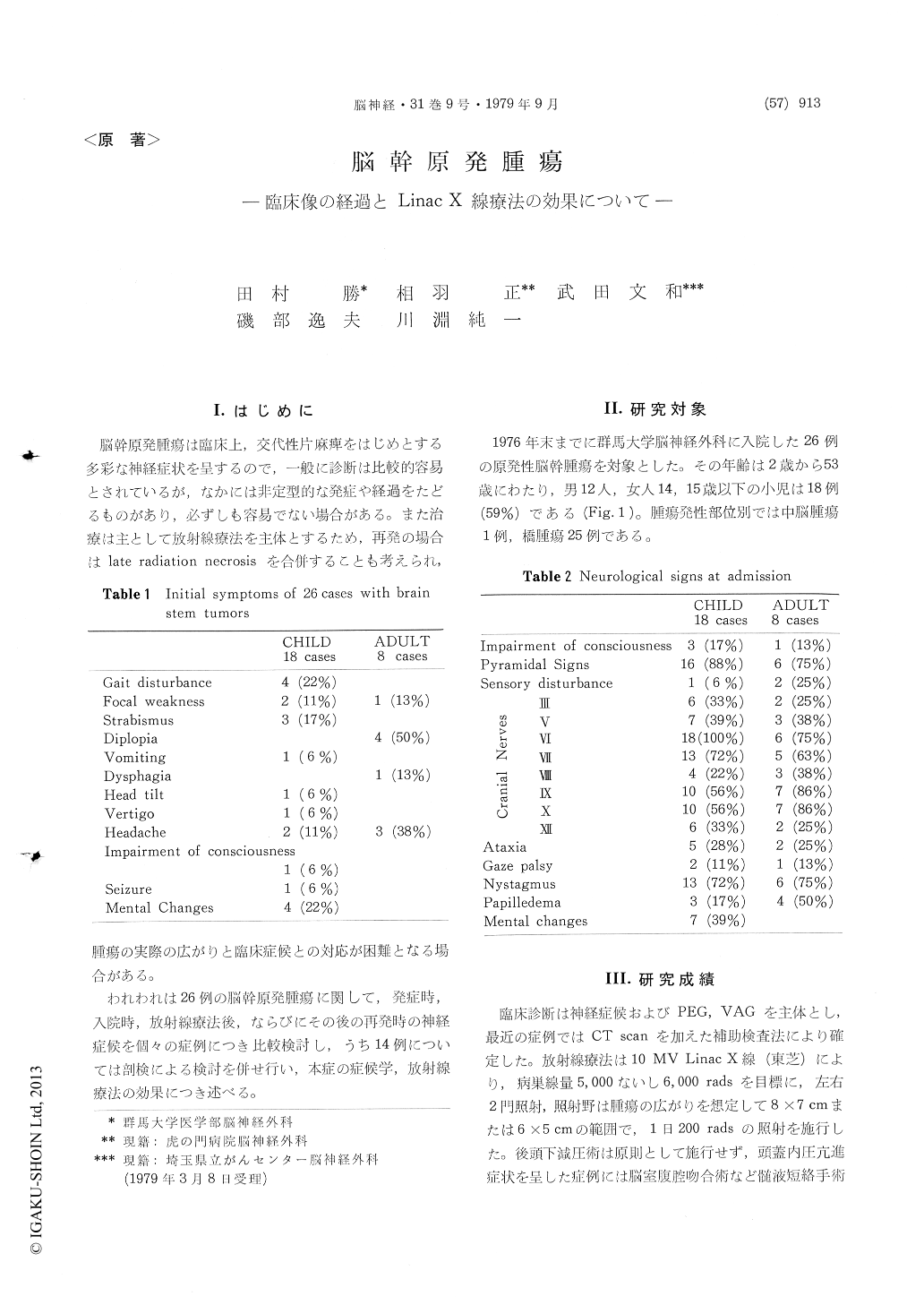Japanese
English
- 有料閲覧
- Abstract 文献概要
- 1ページ目 Look Inside
I.はじめに
脳幹原発腫瘍は臨床上,交代性片麻痺をはじめとする多彩な神経症状を呈するので,一般に診断は比較的容易とされているが,なかには非定型的な発症や経過をたどるものがあり,必ずしも容易でない場合がある。また治療は主として放射線療法を主体とするため,再発の場合は1ate radiation necrosisを合併することも考えられ,腫瘍の実際の広がりと臨床症候との対応が困難となる場合がある。
われわれは26例の脳幹原発腫瘍に関して,発症時,入院時,放射線療法後,ならびにその後の再発時の神経症候を個々の症例につき比較検討し,うち14例については剖検による検討を併せ行い,本症の症候学,放射線療法の効果につき述べる。
Because of the nature and the location of tumors arising within the brain stem, the surgically in-accessible region, Linac X-ray irradiation has been playing a major role in the control of these tumors. It is the purpose of this report to document a clinical evaluation of the effect of irradiation in 26 cases with brain stem tumors treated in Depart-ment of Neurosurgery, Gunma University Hospital.
Age of the patient ranged from 2 to 53 years old, 18 (69%) of which were infants and children. Clinical diagnosis was established by exuberant progressive neurological signs including hemiplegia alternans, and confirmed by demonstration of the pontine hypertrophy in pneumoencephalography.
Initial Symptoms : Out of 18 infants and children, gait disturbance or focal weakness were presented in 6 cases. strabismus in 3 cases and headache in 2 cases. In 4 children the illness started with mental changes. In 8 adult cases, diplopia was presented in 4 cases, headache in 3 cases, dysphagia in 1 case and focal weakness in 1 case, respectively. Three patients showed abrupt onset of cranialnerve palsy like vascular accident.
Neurological Signs on Admission: Motor distur-bance combined with cranial nerve palsies, which were observed 22 out of 26 patients, were the most dominant symptoms. Frequency of cranial nerve palsies was as follows; Abducens nerve was affected in 24 cases, facial nerve in 18, glossopharyngeal nerve in 17, trigeminal nerve in 10, oculomotor and hypoglossal nerve in 8 cases, respectively. Cerebeller signs were presented in 7 cases, nystag-mus in 19 cases, gaze palsy in 3 cases, signs of intracranial hypertension in 7 cases and impairment of consciousness in 4 cases. Mental changes were presented in 7 children.
Effect of Irradiation: Sixteen cases in our series were treated by supervoltage irradiation. The dosage of irradiation was 5,000 to 6,000 rads given over a period of five weeks. Patients given radio-therapy usually started to improve after the first two weeks, and this improvement continued during radiotherapy. In 9 patients, abnormal neurological signs were mostly resolved, but in 7 patients the treatment had no effect on the clinical signs. It was observed that the irradiation-responsive cases had longer duration of symptoms prior to diagnosis than the nonresponsive cases. The pyramidal signs and facial nerve palsy disappeared in almost all the responsive patients when the radiotherapy was completed. Effect to the other cranial nerves had also been observed in varying degree. Response to nystagmus and cerebeller signs varied from case to case.
Readmission was required after certain length of period of improvement, ranging from two to six months. The second irradiation was given but response was scarcely obtained. The length of sur-vival time with irradiation was variable, mostly within nineteen months, but never exceed ten months in the cases with no irradiation.
Autopsy was performed in 14 cases, and revealed tumors to be infiltrative with variable size in each cases. Histological diagnosis were astrocytoma, grade II in 2 cases, and grade III or IV in 11 cases. In one case with tumor in the midbrain, mass lesion of coagulation necrosis was found. In the other cases, the tumor tissue showed proliferative character, though hemorrhage and necrosis were frequently found within. Fibrinoid degeneration and fibrosis of the vessels in the tumor tissue were not uncommonly noticed. Radiation necrosis was scarcely found in the surrounding tissue.

Copyright © 1979, Igaku-Shoin Ltd. All rights reserved.


